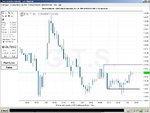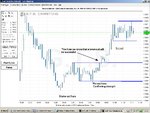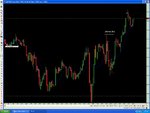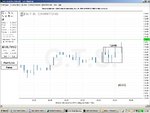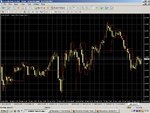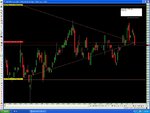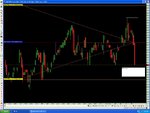You are using an out of date browser. It may not display this or other websites correctly.
You should upgrade or use an alternative browser.
You should upgrade or use an alternative browser.
The Wanderer
Member
- Messages
- 90
- Likes
- 0
Thanks for the advice JillyB.
One of those occasions when a quick "hit and run " for the 5 points would have been much better.Must watch those candles as well as upcoming news !! 😱 😱
A mistake not to be made again - hopefully !! 🙄 🙄
One of those occasions when a quick "hit and run " for the 5 points would have been much better.Must watch those candles as well as upcoming news !! 😱 😱
A mistake not to be made again - hopefully !! 🙄 🙄
VSATrader
Guest
- Messages
- 160
- Likes
- 26
Pointers to Darvas
If you would like to know if Darvas is going to be sucessful then you need to beable to read the background information. If weakness appears, then it will not just vanish, it will linger as will strength. I have attached a chart to explain what I mean which might help those new to Darvas.
Regards VSATrader
If you would like to know if Darvas is going to be sucessful then you need to beable to read the background information. If weakness appears, then it will not just vanish, it will linger as will strength. I have attached a chart to explain what I mean which might help those new to Darvas.
Regards VSATrader
Attachments
neil
Legendary member
- Messages
- 5,169
- Likes
- 753
memories
Reminds me of Tom Williams' book - 😉
VSATrader said:If you would like to know if Darvas is going to be sucessful then you need to beable to read the background information. If weakness appears, then it will not just vanish, it will linger as will strength. I have attached a chart to explain what I mean which might help those new to Darvas.
Regards VSATrader
Reminds me of Tom Williams' book - 😉
VSATrader
Guest
- Messages
- 160
- Likes
- 26
neil said:Reminds me of Tom Williams' book - 😉
Ah, how well I know this book!
VSATrader
Guest
- Messages
- 160
- Likes
- 26
BigK said:Can someone define a Darvas box ?
Hello;
If you look through these posts from page one, then you will see various links to websites which give a broad definition of the Darvas method, we are trading it and discussing our results here.
Regards VSATrader
VSATrader
Guest
- Messages
- 160
- Likes
- 26
BigK said:Can someone define a Darvas box ?
If you look at the box I have drawn, then you will see that I have taken a new high to the area we are watching, and the low in the same area, then as the price breaks the high, I have been able to draw the box which represents a breakout.
Hope this helps.
Regards VSATrader
Attachments
Last edited:
JillyB
Established member
- Messages
- 791
- Likes
- 38
Darvas Box Explained - Jilly's Method
Sorry for the delay in replying to this.
Hopefully the following explanation should help - it's the same as I posted on the 'Live Cable Trading' thread.
According to the Darvas theory the box top has to be put in first and this has to remain unbreached for a minimum of 5 candles.
On candle 3 if the box top is still in place you put in the box bottom - there seems to be a little discrepancy here as to where that should be. For instance if the low of candle2 is lower than candle 3, which do you use? I tend to go with the lower low to set the box base.
If the box base is breached on candle 4 or 5, then it is reset and this becomes candle 3 (so you need another 2 candles after the box base is set to confirm it). During all this time the box top must not be breached.
Once you have this then your Darvas box is set and you can wait for a breakout either through the top or the bottom. When this happens, the opposite side of the box becomes your stop loss.
One thing I do, rightly or wrongly, is that if the price consolidates more - say over 10-15 candles -and there is a smaller box formed within a larger box, then I reset the parameters to the smaller box. This is so when the breakout does occur, I can hopefully be straight in there with a trade.
To do this the smaller boxes have to form inside the first one, AFTER it has totally formed. So I would be looking for a new high inside the first box after it has fully formed. If this smaller box doesn’t didn't form fully before there is a breakout, then the first box still holds firm.
Unless the breakout candle has some momentum to it, then I prefer to take just the 5 pips. A lot of the time you will find the Cable reverses, or consolidates more at this new level, so taking 5 pips is nearly all that you will get.
But on trades where the candle has some momentum to it. Take Friday and the 8.45am breakout. The first part of this, didn't hit my target, it then retraced a little before breaking through with a very positive thrust candle. On this I traded the candle, trailing my stop up after it and took 41 pips ( I probably could have got more), but I was happy with that.
On the other trades at 11.30am and 13.15pm, there was less momentum, so 5 pip profit was safe.
I have noticed that there is usually 1 breakout situation per day where a good number of pips can be taking. It doesn't usually happen twice in one day (quite rarely), so once I've pocketed the pips from an early day breakout, then I'm happy to just take 5 pips at all the following ones.
sonvolt10 said:JillyB,
Can I ask what methodoligy you use to construct your boxes.
There are various links to different URL's concerning Darvas Boxes and to draw them but they all differ is some respects.
I was curious as to your approach.
Thanks
Sorry for the delay in replying to this.
Hopefully the following explanation should help - it's the same as I posted on the 'Live Cable Trading' thread.
According to the Darvas theory the box top has to be put in first and this has to remain unbreached for a minimum of 5 candles.
On candle 3 if the box top is still in place you put in the box bottom - there seems to be a little discrepancy here as to where that should be. For instance if the low of candle2 is lower than candle 3, which do you use? I tend to go with the lower low to set the box base.
If the box base is breached on candle 4 or 5, then it is reset and this becomes candle 3 (so you need another 2 candles after the box base is set to confirm it). During all this time the box top must not be breached.
Once you have this then your Darvas box is set and you can wait for a breakout either through the top or the bottom. When this happens, the opposite side of the box becomes your stop loss.
One thing I do, rightly or wrongly, is that if the price consolidates more - say over 10-15 candles -and there is a smaller box formed within a larger box, then I reset the parameters to the smaller box. This is so when the breakout does occur, I can hopefully be straight in there with a trade.
To do this the smaller boxes have to form inside the first one, AFTER it has totally formed. So I would be looking for a new high inside the first box after it has fully formed. If this smaller box doesn’t didn't form fully before there is a breakout, then the first box still holds firm.
Unless the breakout candle has some momentum to it, then I prefer to take just the 5 pips. A lot of the time you will find the Cable reverses, or consolidates more at this new level, so taking 5 pips is nearly all that you will get.
But on trades where the candle has some momentum to it. Take Friday and the 8.45am breakout. The first part of this, didn't hit my target, it then retraced a little before breaking through with a very positive thrust candle. On this I traded the candle, trailing my stop up after it and took 41 pips ( I probably could have got more), but I was happy with that.
On the other trades at 11.30am and 13.15pm, there was less momentum, so 5 pip profit was safe.
I have noticed that there is usually 1 breakout situation per day where a good number of pips can be taking. It doesn't usually happen twice in one day (quite rarely), so once I've pocketed the pips from an early day breakout, then I'm happy to just take 5 pips at all the following ones.
turtle trader
Active member
- Messages
- 172
- Likes
- 6
Hi Jilly
Thanks for your explanation. Could you let us know how you manage your stop loss - If you're using the other side of the box as a stop then i'd imagine that this would normally be significantly greater than 5 pips, leaving you with an undesirable R:R ratio.
Is there anything you do to mitigate this?
Simon
Thanks for your explanation. Could you let us know how you manage your stop loss - If you're using the other side of the box as a stop then i'd imagine that this would normally be significantly greater than 5 pips, leaving you with an undesirable R:R ratio.
Is there anything you do to mitigate this?
Simon
JillyB said:Sorry for the delay in replying to this.
Hopefully the following explanation should help - it's the same as I posted on the 'Live Cable Trading' thread.
According to the Darvas theory the box top has to be put in first and this has to remain unbreached for a minimum of 5 candles.
On candle 3 if the box top is still in place you put in the box bottom - there seems to be a little discrepancy here as to where that should be. For instance if the low of candle2 is lower than candle 3, which do you use? I tend to go with the lower low to set the box base.
If the box base is breached on candle 4 or 5, then it is reset and this becomes candle 3 (so you need another 2 candles after the box base is set to confirm it). During all this time the box top must not be breached.
Once you have this then your Darvas box is set and you can wait for a breakout either through the top or the bottom. When this happens, the opposite side of the box becomes your stop loss.
One thing I do, rightly or wrongly, is that if the price consolidates more - say over 10-15 candles -and there is a smaller box formed within a larger box, then I reset the parameters to the smaller box. This is so when the breakout does occur, I can hopefully be straight in there with a trade.
To do this the smaller boxes have to form inside the first one, AFTER it has totally formed. So I would be looking for a new high inside the first box after it has fully formed. If this smaller box doesn’t didn't form fully before there is a breakout, then the first box still holds firm.
Unless the breakout candle has some momentum to it, then I prefer to take just the 5 pips. A lot of the time you will find the Cable reverses, or consolidates more at this new level, so taking 5 pips is nearly all that you will get.
But on trades where the candle has some momentum to it. Take Friday and the 8.45am breakout. The first part of this, didn't hit my target, it then retraced a little before breaking through with a very positive thrust candle. On this I traded the candle, trailing my stop up after it and took 41 pips ( I probably could have got more), but I was happy with that.
On the other trades at 11.30am and 13.15pm, there was less momentum, so 5 pip profit was safe.
I have noticed that there is usually 1 breakout situation per day where a good number of pips can be taking. It doesn't usually happen twice in one day (quite rarely), so once I've pocketed the pips from an early day breakout, then I'm happy to just take 5 pips at all the following ones.
The Darvas Project (to be reviewed in 6 weeks time)
Your reply is very much appreciated. I concur that a beginner would find the rules unambiguous and easy to trade, but simplicity is not a sufficient reason in itself.
I like your suggestion that we look at this thread as a kind of project and hope that Darvas fans will take up my challenge to:
(a) illustrate how these boxes relate to market activity and can therefore be predictive
(b) are AT LEAST equivalent in efficacy to other methods, because that in itself would justify beginners utilising them, even if experienced traders need other tools.
(c) to provide some measures of success, profitability and useage by experienced forex traders
Keeping an open mind is crucial - this I will agree with.
Thanks to both you and Neil for providing some balance to the thread and I will look forward to watching the progress of the project and the contributions by the Darvas camp.
Charlton
Trendietrendie said:Hi Charlton,
I think D-Boxes are simply another method of trading, not necessarily superior, just different.
A beginner may feel more comfortable with the unambiguity of the rules.
( personally, my only experience and comfort-zone is with MAs. )
I dont know what the success rate is.
I dont know how prediction rates are in comparison with other methods.
I dont know what percentage are using D-Boxes for FX.
tone down: I was being supportive and enthusiastic. 🙂
I dont use D-Boxes, I use MAs. I will be observant of D-Boxes, but not trade them.
I may occassionally point a Box forming, and see the response.
This thread should be seen as a project, where a set of rules are posted, and then to see if experience proves or disproves the effectiveness of D-Boxes.
The answers you want with regards to success rates, and prediction rates are unknown, but this thread could act as a study zone, where interested parties can pass on their knowledge, and to see if several people, all adding their bit results in improved performances.
I didnt intend to suggest the answers already exist, or that this method is superior, or not without risks. I am curiously to see where this thread will be in say 6 weeks from now.
( the Live Cable Thread started off with traders trying to prove how clever they were, and getting more pips than others, and eventually matured into exploring different ideas, and sharing strategies, and warning each other of news events, etc. )
hope that helps.
Your reply is very much appreciated. I concur that a beginner would find the rules unambiguous and easy to trade, but simplicity is not a sufficient reason in itself.
I like your suggestion that we look at this thread as a kind of project and hope that Darvas fans will take up my challenge to:
(a) illustrate how these boxes relate to market activity and can therefore be predictive
(b) are AT LEAST equivalent in efficacy to other methods, because that in itself would justify beginners utilising them, even if experienced traders need other tools.
(c) to provide some measures of success, profitability and useage by experienced forex traders
Keeping an open mind is crucial - this I will agree with.
Thanks to both you and Neil for providing some balance to the thread and I will look forward to watching the progress of the project and the contributions by the Darvas camp.
Charlton
JillyB
Established member
- Messages
- 791
- Likes
- 38
turtle trader said:Hi Jilly
Thanks for your explanation. Could you let us know how you manage your stop loss - If you're using the other side of the box as a stop then i'd imagine that this would normally be significantly greater than 5 pips, leaving you with an undesirable R:R ratio.
Is there anything you do to mitigate this?
Simon
Actually no, there isn't anything.
True the R:R ratio is quite frightening, but we seem to have a high percentage of 5 pip wins that don't get totally turned around by the odd loss.
So I'm still going with the theory of the opposite side of the box being the stop at the moment. However I am reviewing this, to see if it can be reduced to say 50% of the box width when trading during the give 'time zones'.
I need to watch this first to see if, and how many times, I get stopped out on this when it would have gone on to be a winning trade.
It's all still work in progress.
JillyB
Established member
- Messages
- 791
- Likes
- 38
smbtnt said:JillyB,
Thank you for a coherent explanation of the darvas model, all seems to be clear and well defined for me except qualifying a '' a box high or low''
Can this be classified please.
A box high can be the top of an uptrend, or the top of a bounce. It's taken as the high of the candle.
It's not a high formed within a downtrend sequence of candles. The sort where you get on candle on a 5 min chart that forms a higher high than the previous. This would not be a box top.
Once you have the high in place from the top of a bounce or uptrend then the box bottom is the low of the third candle (or second if this lower). If the box bottom is breached before candle 5 has formed, you can reset it and the new candle forming the base becomes candle 3 again.
Does this make sense?
JillyB
Established member
- Messages
- 791
- Likes
- 38
Yesterday I was discussing if it would be possible to 'reverse engineer' the Darvas boxes on the Forex. This was so that, at the end of a downtrend, you would form the box base first and then look for the box top.
This morning on the 5 min chart we had a short downtrend which ended with the 8.55am candle having a long tail. I used this to form the box base and then waited until the 3rd candle to form the box top. As it was the 4th candle broke this high and so the box top was reset (just as you would have done for a box bottom on the real Darvas method). Therefore candle 4 became candle 3 and this time the high held until the box was fully formed.
The box was breached at 9.25am (within a trading 'time zone') however - allowing 1 pip tolerance on getting in and 3 pip spread - the most that could have been achieved out of this was 4 pips. (A total move up of 8 pips before it reversed.)
That high formed on the 9.30am candle has now become a box top and the low of the 10.00am candle has become a box base. We are still trading within that range and as the box has fully formed it may be possible now to look for a smaller one forming inside. Perhaps the current candle at 10.25am will form the top of this - I will have to wait and see.
So with regard to 'reverse engineering' Darvas, the jury is still out on this. I'd like to do some more testing. So far it hasn't failed, but neither has it given the 5 pip profit that I look for. More testing is definitely required.
This morning on the 5 min chart we had a short downtrend which ended with the 8.55am candle having a long tail. I used this to form the box base and then waited until the 3rd candle to form the box top. As it was the 4th candle broke this high and so the box top was reset (just as you would have done for a box bottom on the real Darvas method). Therefore candle 4 became candle 3 and this time the high held until the box was fully formed.
The box was breached at 9.25am (within a trading 'time zone') however - allowing 1 pip tolerance on getting in and 3 pip spread - the most that could have been achieved out of this was 4 pips. (A total move up of 8 pips before it reversed.)
That high formed on the 9.30am candle has now become a box top and the low of the 10.00am candle has become a box base. We are still trading within that range and as the box has fully formed it may be possible now to look for a smaller one forming inside. Perhaps the current candle at 10.25am will form the top of this - I will have to wait and see.
So with regard to 'reverse engineering' Darvas, the jury is still out on this. I'd like to do some more testing. So far it hasn't failed, but neither has it given the 5 pip profit that I look for. More testing is definitely required.
yes, what I have a hard time gauging is whether the bounce is a pullback or not and whether entering a trade on the break of the recent high after 5 box b/o is valid.
Pullbacks and retracements, how is this defined in terms of darvas strategy or how would you define it?
Pullbacks and retracements, how is this defined in terms of darvas strategy or how would you define it?
JillyB
Established member
- Messages
- 791
- Likes
- 38
smbtnt said:yes, what I have a hard time gauging is whether the bounce is a pullback or not and whether entering a trade on the break of the recent high after 5 box b/o is valid.
Pullbacks and retracements, how is this defined in terms of darvas strategy or how would you define it?
I'm tending not to think of wether it is a pullbacks or retracements with regard to the Darvas formation. At the moment I'm keeping it quite simple for my test data.
1. If a box forms and the breakout occurs within one of my posted 'time zones' then it is valid.
2. If a box forms and the breakout occurs outside one of my 'time zones' then it is invalid - even if it is a good pip making trade.
These are the only two criteria I am using to define whether or not to trade. I'm not even looking at support/resistance lines at the moment, MA's or anything.
At the moment I'm only considering the correct forming Darvas boxes for the test - not the 'reverse engineered' ones I mentioned earlier.
Similar threads
- Replies
- 39
- Views
- 23K
- Replies
- 6
- Views
- 4K

